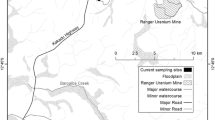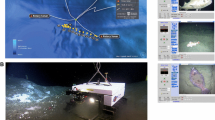Abstract
Researchers attempting to study the presence, abundance, size, and behavior of fish species in northern and arctic climates during winter face many challenges, including the presence of thick ice cover, snow cover, and, sometimes, extremely low temperatures. This paper describes and compares the use of video and acoustic cameras for determining fish presence and behavior in lakes, rivers, and streams with ice cover. Methods are provided for determining fish density and size, identifying species, and measuring swimming speed and successful applications of previous surveys of fish under the ice are described. These include drilling ice holes, selecting batteries and generators, deploying pan and tilt cameras, and using paired colored lasers to determine fish size and habitat associations. We also discuss use of infrared and white light to enhance image-capturing capabilities, deployment of digital recording systems and time-lapse techniques, and the use of imaging software. Data are presented from initial surveys with video and acoustic cameras in the Sagavanirktok River Delta, Alaska, during late winter 2004. These surveys represent the first known successful application of a dual-frequency identification sonar (DIDSONTM) acoustic camera under the ice that achieved fish detection and sizing at camera ranges up to 16 m. Feasibility tests of video and acoustic cameras for determining fish size and density at various turbidity levels are also presented. Comparisons are made of the different techniques in terms of suitability for achieving various fisheries research objectives. This information is intended to assist researchers in choosing the equipment that best meets their study needs.
Similar content being viewed by others
References
Belcher EO (2004) Case study: Alaska Department of Fish and Game uses DIDSON to count salmon swimming up-river to spawn. Available at http://www.soundmetrics.com/NEWS/REPORTS/AlaskaFishCaseStudy_ WApdf.
Belcher EO, Matsuyama B, Trimble GM (2001) Object identification with acoustic lenses. In: An Ocean Odyssey – Oceans 2001 MTS/IEEE Conference Proceedings, vol. 1. Marine Technology Society, Washington, DC, pp 6–11
Belcher EO, Hanot W, Burch J (2002) Dual-frequency identification sonar. In: Underwater Technology 2002 – Proceedings of the 2002 International Symposium on Underwater Technology. Institute of Electrical and Electronic Engineers, Inc., Piscataway, NJ, pp 187–192
Bergström BI, Gustavsson A, Strömberg J-O (1992) Determination of abundance of gelatinous plankton with a remotely operated vehicle (ROV). Arch Hydrobiol 36:59–65
Brown RS (1999) Fall and early winter movements of cutthroat trout, Oncorhynchus clarki, in relation to water temperature and ice conditions in Dutch Creek, Alberta. Environ Biol Fish 55:359–386
Brown RS, Power G, Beltaos S (2001) Winter movements and habitat use of riverine brown trout, white sucker and common carp in relation to flooding and ice break-up. J Fish Biol 59:1126–1141
Carlson LD, Quinn MS (2005) Evaluating the effectiveness of instream habitat structures for overwintering stream salmonids: a test of underwater video. North Am J Fish Manage 25:130–137
Crawford RE, Jorgenson JK (1996) Quantitative studies of Arctic cod, Boreogadus saida schools: important energy stores in the Arctic food web. Arctic 49:181–193
Crawford RE, Jorgenson J (1990) Density distribution of fish in the presence of whales at the Admiralty Inlet landfast ice edge. Arctic 43:215–222
Fish JP, Carr HA (1990) Sound underwater images, a guide to the generation and interpretation of side scan sonar data. Lower Cape Pub Co, Orleans, MA, pp 189
Foote KG (1987) Fish target strengths for use in echo integrator surveys. J Acous Soc Am 82:981–987
Gerland S, Winther J-G, Ørbæk JB, Ivanov BV (1999) Physical properties, spectral reflectance and thickness development of first year fast ice in Kongsfjorden, Svalbard. Polar Res 18:275–282
Hartman KJ, Nagy BW (2005) A target strength and length relationship for striped bass and white perch. Trans Am Fish Soc 134:375–380
Harvey BC, Nakamoto RJ, White JL (1999) Influence of large woody debris and a bankfull flood on movement of adult resident coastal cutthroat trout (Oncorhynchus clarki) during fall and winter. Can J Fish Aquat Sci 56:2161–2166
Hop H, Poltermann M, Lønne OJ, Falk-Petersen S, Korsnes R, Budgell WP (2000) Ice-amphipod distribution relative to ice density and under-ice topography in the northern Barents Sea. Polar Biol 23:357–367
Jobling M (1995) Environmental biology of fishes. Fish and Fisheries Series 16, Chapman and Hall, London
Johnson RL, McKinstry CA, Mueller RP (2004) Chinook salmon adult abundance monitoring – hydroacoustic assessment of chinook salmon escapement to the Secesh River, Idaho. PNNL-14513, Pacific Northwest National Laboratory, Richland, WA
Johnson GE, Hanks ME, Hedgespeth JB, McFadden BD, Moursund RA, Mueller RP, Skalski JR (2003) Hydroacoustic evaluation of turbine intake J-occlusions at the Dalles Dam. PNWD-3226, Battelle-Pacific Northwest Division, Richland, WA
Lines JA, Tillett RD, Ross LG, Chan D, Hockaday S, McFarlane NJB (2001) An automated image-based system for estimating the mass of free-swimming fish. Comput Electron Agric 31:151–168
Lythgoe JN (1988) Light and vision in the aquatic environment. In: Atema J, Fay RR, Popper AN, Tavolga WN (eds) Sensory biology of aquatic animals. Springer-Verlag, New York, pp 57–82
Maxwell SL, Gove NE (2004) The feasibility of estimating migrating salmon passage rates in turbid rivers using a Dual Frequency Identification Sonar (DIDSON) 2002. Regional Information Report 1 No. 2A04-05, Alaska Department of Fish and Game Division of Commercial Fisheries, Anchorage, AK
Mueller RP, Moursund RA, Degerman TM, McMichael GA (2003) Feasibility of monitoring fall Chinook salmon fallback at Priest Rapids Dam using an acoustic camera 2001. In: McMichael GA et al (eds) Chinook salmon in the priest rapids project, Technical Appendix E-4.B, Public Utility District No. 2 of Grant County. Ephrata, WA, pp 4.4-1–4.4-18. Available at http://www.gcpud.org/relicensing.htm
Nelson JA, Claireaux G (2005) Sprint swimming performance of juvenile European Sea Bass. Trans Am Fish Soc 134:1274–1284
Oliver JS, Kvitek RG (1984) Side-scan sonar records and diver observations of gray whale (Eschrichticus robustus) feeding grounds. Biol Bull Acad Sci USSR 167:264–269
Pike D, Welch HE (1990) Spatial and temporal distribution of sub-ice macrofauna in the Barrow Strait area, Northwest Territories. Can J Fish Aquat Sci 47:81–91
Tiffan KE, Rondorf DW, Skalicky JJ (2004) Imaging fall Chinook salmon redds in the Columbia River with dual frequency identification sonar. North Am J Fish Manage 24:1421–1426
Trudel M, Boisclair D (1996) Estimation of fish activity costs using underwater video cameras. J Fish Biol 48:40–53
Wadhams P (1988) The underside of Arctic sea ice imaged by sidescan sonar. Nature 333:161–164
Weiland MA, Carlson TJ (2003) Technologies for evaluating fish passage through turbines. PNNL-14437, Pacific Northwest National Laboratory, Richland, WA (http://www.hydropower.id.doe.gov/)
Werner I, Lindemann F (1997) Video observations of the underside of arctic sea ice – features and morphology on medium and small scales. Polar Res 16:27–36
Whittington RJ, Forsberg CF, Dowdeswell JA (1997) Seismic and side-scan sonar investigations of recent sedimentation in an ice-proximal glacimarine setting, Kongsfjorden, North-west Spitsbergen. In: Davies TA, Bell T, Cooper A, Josenhans H, Polyak L, Solhein A, Stoker MS (eds) Glaciated continental margins: an atlas of acoustic images. Chapman and Hall, London, pp 175–178
Acknowledgements
The research on which this paper is based was funded in part by the Minerals Management Service, US Department of Interior, Anchorage, Alaska. The authors extend their appreciation to Duane Neitzel, David Geist, Andrea Currie, and Terri Gilbride of the Pacific Northwest National Laboratory (PNNL), for helpful comments on the manuscript, and to John Stephenson, also of PNNL, for assistance with deployment systems. Pacific Northwest National Laboratory is operated by Battelle for the US Department of Energy under Contract DE-AC05-76RL01830.
Author information
Authors and Affiliations
Corresponding author
Rights and permissions
About this article
Cite this article
Mueller, R.P., Brown, R.S., Hop, H. et al. Video and acoustic camera techniques for studying fish under ice: a review and comparison. Rev Fish Biol Fisheries 16, 213–226 (2006). https://doi.org/10.1007/s11160-006-9011-0
Received:
Accepted:
Published:
Issue Date:
DOI: https://doi.org/10.1007/s11160-006-9011-0




